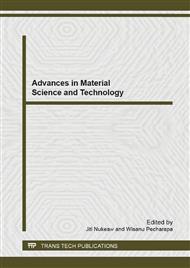p.242
p.247
p.252
p.257
p.262
p.267
p.273
p.279
p.284
Polymer-Coated Single-Walled Carbon Nanotubes for Ethanol and Dichloromethane Discrimination
Abstract:
Sensor response and pattern recognition of polymer-coated single-walled carbon nanotubes (SWNTs) were investigated. Printed circuit board (PCB) with Cu/Au interdigitated electrode was used as sensor platform. SWNTs network was firstly formed on PCB by drop-casting. For polymer-coated SWNTs preparation, poly(methyl methacrylate) (PMMA) and thiophene were employed as polymers to coat on SWNTs by spin coating; PMMA/SWNTs and thiophene/SWNTs. Raman spectra showed no obvious structure changes of SWNTs after polymer coating. Next, gas sensing test was conducted. Pristine SWNTs, PMMA/SWNTs and thiophene/SWNTs were exposed to vapors of ethanol and dichloromethane at room temperature. From normalized sensor response results, it was found that pristine SWNTs and PMMA/SWNTs showed the highest response to ethanol and dichloromethane vapors, respectively. In order to discriminate vapors between ethanol and dichloromethane, pattern recognition technique was utilized. Principal component analysis (PCA) results showed that pattern recognition of ethanol and dichloromethane vapors can be discriminated by using pristine SWNTs and polymer-coated SWNTs sensors.
Info:
Periodical:
Pages:
267-272
Citation:
Online since:
September 2013
Price:
Сopyright:
© 2013 Trans Tech Publications Ltd. All Rights Reserved
Share:
Citation:


